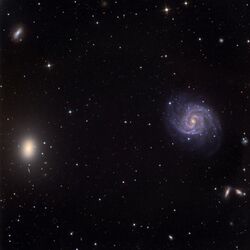Astronomy:NGC 1052
| NGC 1052 | |
|---|---|
 NGC 1052 (center left) and NGC 1042 (center right) as imaged by Schulman Telescope | |
| Observation data (J2000 epoch) | |
| Right ascension | 02h 41m 04.79851s[1] |
| Declination | −08° 15′ 20.7517″[1] |
| Redshift | 0.004930[1] |
| Helio radial velocity | 1474 ± 26 km/s[1] |
| Distance | 62.0 Mly (19.00 Mpc)[2] |
| Group or cluster | NGC 1052 Group[1] |
| Apparent magnitude (V) | 10.47[2] |
| Apparent magnitude (B) | 11.41[2] |
| Characteristics | |
| Type | E4[2] |
| Apparent size (V) | 3.0′ × 2.1′[2] |
| Other designations | |
| MCG-01-07-034, PGC 10175[1] | |
NGC 1052 is an elliptical galaxy in the constellation Cetus. It was discovered on January 10, 1785 by the astronomer William Herschel.[3] It is a member of the eponymous NGC 1052 Group.[1]
Features
NGC 1052 is located at a distance of around 63 million light years from the Milky Way,[4] and has a LINER-type active galactic nucleus which signals the intense starburst activity in the galaxy's center[5] that were confirmed with observations with better resolution showing a number of star-forming regions and young star clusters.[6]
NGC 1052 shows also two small jets emerging from its nucleus as well as a very extended disc of neutral hydrogen, far larger than the galaxy itself.[7] Additionally, the stars and the ionized gas rotate along different axes.[8] All these features suggesting a gas-rich galaxy collided and merged with it 1 billion years ago producing all the above features.[6]
The shape of NGC 1052 is thought to be a triaxial ellipsoid. The longest axis of the ellipsoid is probably aligned at a position angle of −41°, which is the axis around which the ionized gas would be rotating.[8]
A scale image of NGC 1052 and its satellite galaxies is available at the reference.[9]
Central black hole
NGC 1052 hosts a rapidly rotating supermassive black hole with a mass of 154 million M☉[10] with a large magnetic field of between 0.02 and 8.3 Tesla, which, according to PhD student Anne-Kathrin Baczko, the leader of the team that made this discovery, provides enough magnetic energy to power the previously mentioned twin relativistic jets.[11]
The location of this black hole is the most precisely known in the universe, with the exception of Sagittarius A*, the supermassive black hole found at the heart of our own galaxy.[11]
See also
- NGC 1052-DF2, a galaxy assumed to be associated with NGC 1052, and which appears to have little or no dark matter
- NGC 1052-DF4, another galaxy assumed to be associated with NGC 1052, and which appears to have little or no dark matter[12]
References
- ↑ Jump up to: 1.0 1.1 1.2 1.3 1.4 1.5 1.6 "NGC 1052". SIMBAD. Centre de données astronomiques de Strasbourg. http://simbad.u-strasbg.fr/simbad/sim-basic?Ident=NGC+1052.
- ↑ Jump up to: 2.0 2.1 2.2 2.3 2.4 Gil de Paz, Armando et al. (December 2007). "The GALEX Ultraviolet Atlas of Nearby Galaxies". The Astrophysical Journal Supplement Series 173 (2): 185–255. doi:10.1086/516636. Bibcode: 2007ApJS..173..185G.
- ↑ Seligman, Courtney. "New General Catalogue objects: NGC 1050 - 1099". http://cseligman.com/text/atlas/ngc10a.htm#1052. Retrieved 2021-02-19.
- ↑ J. L. Tonry; A. Dressler; J.P. Blakeslee; E.A. Ajhar; A.B. Fletcher; G. A. Luppino; M. R. Metzger; C.B. Moore (2001). "The SBF Survey of Galaxy Distances. IV. SBF Magnitudes, Colors, and Distances". Astrophysical Journal 546 (2): 681–693. doi:10.1086/318301. Bibcode: 2001ApJ...546..681T.
- ↑ Pierce, Michael; Brodie, Jean P.; Forbes, Duncan A.; Beasley, Michael A.; Proctor, Robert; Strader, Jay (2005). "The evolutionary history of the elliptical galaxy NGC 1052". Monthly Notices of the Royal Astronomical Society 358 (1): 419–431. doi:10.1111/j.1365-2966.2005.08778.x. Bibcode: 2005MNRAS.358..419P.
- ↑ Jump up to: 6.0 6.1 Fernández-Ontiveros, J.A.; López-Sanjuan, C.; Montes, M.; Prieto, M. A.; Acosta-Pulido, J.A. (2011). "The most recent burst of star formation in the massive elliptical galaxy NGC 1052". Monthly Notices of the Royal Astronomical Society Letters 411 (1): L21–L25. doi:10.1111/j.1745-3933.2010.00985.x. Bibcode: 2011MNRAS.411L..21F.
- ↑ "Notes for NGC 1052". Cal Tech. http://ned.ipac.caltech.edu/cgi-bin/nph-datasearch?search_type=Note_id&objid=7496&objname=NGC%201052&img_stamp=YES&hconst=73.0&omegam=0.27&omegav=0.73&corr_z=1&of=table.
- ↑ Jump up to: 8.0 8.1 Davies, R. L.; Illingworth, G. D. (1986). "The dynamics of the active galaxy NGC 1052". The Astrophysical Journal 302: 234. doi:10.1086/163985. Bibcode: 1986ApJ...302..234D.
- ↑ Dokkum, Pieter. "image of NGC 1052". https://twitter.com/DokkumPieter/status/1087182448348286981.
- ↑ Brenneman, L. W.; Weaver, K. A.; Kadler, M.; Tueller, J.; Marscher, A.; Ros, E.; Zensus, A.; Kovalev, Y.Y. et al. (2009). "Spectral analysis of the accretion flow in NGC 1052 with Suzaku". The Astrophysical Journal 698 (1): 528–540. doi:10.1088/0004-637X/698/1/528. Bibcode: 2009ApJ...698..528B.
- ↑ Jump up to: 11.0 11.1 "Twin jets pinpoint the heart of an active galaxy". phys.org. https://phys.org/news/2016-09-twin-jets-heart-galaxy.html.
- ↑ Van Dokkum, Pieter; Danieli, Shany; Abraham, Roberto; Conroy, Charlie; Romanowsky, Aaron J. (2019). "A Second Galaxy Missing Dark Matter in the NGC 1052 Group". The Astrophysical Journal 874 (1): L5. doi:10.3847/2041-8213/ab0d92. Bibcode: 2019ApJ...874L...5V.
External links
 |

